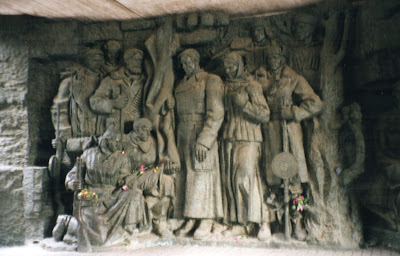Russia and most of the other countries of the FSU today (May 9th) celebrate the end of the Great Patriotic War. According to Soviet and now Russian history the war began June 22, 1941 when Germany invaded the Soviet Union. The war prior to that, when Hitler and Stalin were allies, is ignored. The Moscow times has an article on how Russian children are taught about the Second World War. It is a crime in Russia to not follow the official line and someone was fined and sent to jail for saying that the USSR invaded Poland Sept 17, 1939. The official line, as it was in Soviet times, is that the USSR "liberated" western Ukraine, Poland and the other eastern European countries and territory they invaded and occupied. In much the same way Willie Sutton liberated money held prisoner by banks.
As part of decolonization and decommunization, Ukraine now recognizes the dates of WWII as Sept 1, 1939 to May 7th, 1945. May 9th which has been a holiday in Ukraine for 72 years is now celebrated as as Day of Memory and Reconciliation. Russia, of course, is furious and in response has written Ukraine's part on the war out of their history. Ukraine is fighting back to be recognized for the significant roll played by Ukrainians in the war.
As part of decolonization and decommunization, Ukraine now recognizes the dates of WWII as Sept 1, 1939 to May 7th, 1945. May 9th which has been a holiday in Ukraine for 72 years is now celebrated as as Day of Memory and Reconciliation. Russia, of course, is furious and in response has written Ukraine's part on the war out of their history. Ukraine is fighting back to be recognized for the significant roll played by Ukrainians in the war.
The Ukrainians carried at least 40% of 27,000,000 losses of the USSR in WWII. The Soviet historiographical concept of the “Great Patriotic War,” however, employed major misperceptions of the Ukrainians’ role and is now being used as a propaganda instrument fueling the war in Donbas. In our series “Understanding the Ukrainians in WWII” we seek to uncover the underreported role of Ukrainians living both in Ukraine and abroad in the most deadly war of the 20th century.Understanding the Ukrainians in WWII. Part 1
In 1999, I was in Kyiv for the May 9th celebration of the end of
the Great Patriotic War. The following pictures are of the war memorial
which is "Soviet Realism". The sculptures are part of the War Museum which has an outdoor component of planes, tanks, guns etc and an indoor component under the Victory statue. A couple of years later, we acquired a guide/translator to take us thorough the museum. The lady cried much of the time as she read the descriptions on the displays.
 |
| Motherland aka Brezhnev's Daughter aka The Iron Baba |







Very powerful public art.
ReplyDeleteIt truly is rather overwhelming, as it was intended to be. Soviet art all carried a political message.
DeleteI don't even want to imagine what it must be like to live in Russia. Every time I read one of your posts I'm more grateful to be living in Canada.
ReplyDeleteYes, Canadians have it very good. I wish more of them realized it. Living in Russian these days is no picnic, ESPECIALLY if you do not keep your head down and your mouth shut. In Stalin's time, even that was not enough to save you, though.
Deletethe art...wow...
ReplyDeletePretty grim stuff, isn't it?
DeleteHuge frightening sculptures. With floral tributes in remembrance of the horrors of war. And I wholeheartedly agree with Diane H's comment above.
ReplyDeleteTanya lost her grandfather and his two brothers in the war. 27 million died in the war plus those who died in the Gulags or during deportation.
DeleteCanada is a wonderful place to live.